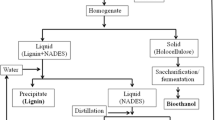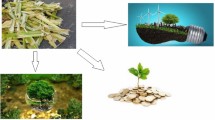Abstract
Penicillium echinulatum was evaluated as a cellulolytic enzyme producer in shaking flasks and bioreactor submerged culture using sugarcane bagasse as carbon source. Sodium hydroxide delignified steam-exploded pretreated bagasse (SDB) and hydrothermal pretreated bagasse had a maximum filter paper activity (FPase) of 2.4 and 2.6 FPU/mL, respectively. Delignified acid pretreated bagasse and Celufloc 200TM (CE) carbon sources displayed maximum FPase of 1.3 and 1.6 FPU/mL while in natura bagasse (INB) provided the lowest enzyme activity, ca. 0.4 FPU/mL. Measurement of surface specific area of lignocellulosic material and scanning electron microscopic images showed a possible correlation between fungal mycelia accessibility to lignocellulosic particles and obtained cellulolytic enzyme activity of fermentation broth. Fed-batch experiments performed in a controlled bioreactor attained the highest value of FPase of 3.7 FPU/mL, enzyme productivity of 25.7 FPU/L h, and enzyme yield from cellulose equal to 134 FPU/g with SDB. Enzyme hydrolysis of steam-pretreated bagasse accomplished with the obtained supernatant of fermentation broth (10 FPU/g of biomass and 5 % w/v) performed better than commercial cellulose complex. The results showed that P. echinulatum has potential to be used as an on-site enzyme platform aiming second bioethanol production from sugarcane lignocellulosic residue.





Similar content being viewed by others
References
Macedo IC (organizer) (2007) Sugarcane’s energy—twelve studies on Brazilian sugarcane agribusiness and its sustainability. 2nd edition, Editora Berlendis, São Paulo, SP, Brazil (http://sugarcane.org/resource-library/books/Sugar%20Canes%20Energy%20-%20Full%20book.pdf)
Zhang YHP, Himmel ME, Mielenz JR (2006) Outlook for cellulase improvement: screening and selection strategies. Biotechnol Adv 24:452–481
Tolan JS (2002) Iogen’s process for producing ethanol from cellulosic biomass. Clean Techn Environ Policy 3:339–345
Sorensen A, Teller PJ, Lubeck PS, Ahring BK (2011) Onsite enzyme production during bioethanol production from biomass: screening for suitable fungal strains. Appl Biochem Biotechnol 164:1058–1070
Martins LF, Kolling D et al (2008) Comparison of Penicillium echinulatum and Trichoderma reesei cellulases in relation to their activity against various cellulosic substrates. Bioresour Technol 19:1417–1424
Camassola M, Bittencourt LR et al (2004) Characterization of the cellulase complex of Penicillium echinulatum. Biocatal Biotransform 22:391–396
Sehnem NT, Bittencourt LR et al (2006) Cellulase production by Penicillium echinulatum on lactose. Appl Microbiol Biotechnol 72:163–167
Camassola M, Dilon AJP (2007) Effect of methylxanthines on production of cellulases by Penicillium echinulatum. J Appl Microbiol 102:478–485
Dillon AJP, Zorgi C (2006) Use of 2-deoxyglucose in liquid media for the selection of mutant strains of Penicillium echinulatum producing increased cellulase and b-glucosidase activities. Appl Microbiol Biotechnol 70:740–746
Mandels M, Reese ET (1957) Induction of cellulase in Trichoderma viride as influenced by carbon sources and metals. J Bacteriol 73:269–278
Ghose TK (1987) Measurement of cellulose activities. Pure Appl Chem 59:257–268
Bailey MJ, Poutanen K (1989) Production of xylanolytic enzymes by strains of Aspergillus. Appl Microbiol Biotechnol 30:5–10
Zhang Y-HP, Hong J, Ye X (2009) Cellulase assays. Methods Mol Biol 581:213–231
Ahamed A, Vermette P (2008) Culture-based strategies to enhance cellulase enzyme production from Trichoderma reesei RUT-C30 in bioreactor culture conditions. Biochem Eng J 40:399–407
Gouveia ER, Nascimento RT, Souto-Maior AM, Rocha GJM (2009) Validation of the methodology for the chemical characterization of the sugarcane bagasse. Quím Nova 32:1500–1503
Bigelow M, Wyman CE (2002) Cellulase production on bagasse pretreated with hot water. Appl Biochem Biotechnol 98:921–934
Palmqvist E, Hahn-Hägerdal B (2000) Fermentation of lignocellulosic hydrolysates. II: inhibitors and mechanisms of inhibition. Bioresour Technol 74:25–33
Grethlein HE (1985) The effect of pore size distribution on the rate of enzymatic hydrolysis of cellulosic substrates. Biotechnology 3:155–160
Ilmén M, Thrane C, Penttilä ME (1996) The glucose repressor gene cre1 of Trichoderma: isolation and expression of a full-length and a truncated mutant form. Mol Gen Genet 251:451–460
Lejeune R, Baron GV (1995) Effect of agitation on growth and enzyme production of Trichoderma reesei in batch fermentation. Appl Microbiol Biotechnol 43:249–258
Camassola M, Dillon AJP (2007) Production of cellulases and hemicellulases by Penicillium echinulatum grown on pretreated sugarcane bagasse and wheat bran in solid state fermentation. J Appl Microbiol 103:2196–2204
Kovács K, Szacks G, Zacchi G (2009) Comparative enzymatic hydrolysis of pretreated spruce by supernatants, whole fermentation broth and washed mycelia of Trichoderma reesei and Trichoderma atrovide. Bioresour Technol 100:1350–1357
Ahmed S, Bashir A, Saleem H, Saadia M, Jamil A (2009) Production and purification of cellulose degrading enzymes from a filamentous fungus Trichoderma harzianum. Pak J Bot 41:1411–1419
Castro AM, Ferreira MC, Cruz JC, Nascimento KC, Rodrigues P, Carvalho DF, Leite SGF, Pereira N Jr (2010) High-yield endoglucanase production by Trichoderma harzianum IOC-3844 cultivated in pretreated sugarcane mill byproduct. Enzym Res. doi:10.4061/2010/854526
Delabona PS, Farinas CS, Silva MR, Azzoni SF, Pradella JGC (2012) Use of a new Trichoderma harzianum strain isolated from the Amazon rainforest with pretreated sugarcane bagasse for on-site cellulase production. Bioresour Technol 107:517–521
Cosgrove DJ (2005) Growth of the plant cell wall. Nat Rev Mol Cell Biol 6:850–861
Walton JD (1994) Deconstructing the cell wall. Plant Physiol 104:1113–1118
Berlin A, Gilkes N, Kilburn D, Bura R, Markov A, Skomarovsky A, Okunev O, Gusakov A, Greg D, Sinitsyn A, Saddler J (2005) Evaluation of novel fungal cellulase preparations for ability to hydrolyze softwood substrates—evidence for the role of accessory enzymes. Enzyme Microb Technol 37:175–184
Kumar R, Wyman CE (2009) Effect of enzyme supplementation at moderate cellulase loadings on initial glucose and xylose release from corn stover solid pretreated by leading technologies. Biotechnol Bioeng 102:457–467
Acknowledgments
The authors would like to thank Dr. Aldo J. P. Dillon for providing the P. echinulatum, the technicians of the National Laboratory of Science and Technology of Bioethanol (CTBE) for assistance during the experiments, and LME/LNLS for technical support during the electron microscopy work.
Author information
Authors and Affiliations
Corresponding author
Rights and permissions
About this article
Cite this article
Pereira, B.M.P., Alvarez, T.M., da Silva Delabona, P. et al. Cellulase On-Site Production from Sugar Cane Bagasse Using Penicillium echinulatum . Bioenerg. Res. 6, 1052–1062 (2013). https://doi.org/10.1007/s12155-013-9340-5
Published:
Issue Date:
DOI: https://doi.org/10.1007/s12155-013-9340-5




